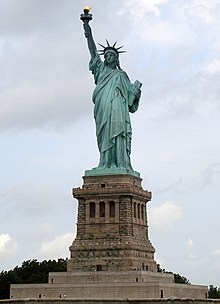
Back زنجار Arabic Verdet Catalan Měděnka Czech Spanskgrønt Danish Verdigro Esperanto Cardenillo Spanish Vaseroheline Estonian Kuprits Basque سبز مسی Persian Vert-de-gris French
| Verdigris | |
|---|---|
| Hex triplet | #43B3AE |
| sRGBB (r, g, b) | (67, 179, 174) |
| HSV (h, s, v) | (177°, 63%, 70%) |
| CIELChuv (L, C, h) | (67, 45, 187°) |
| Source | [1] |
| ISCC–NBS descriptor | Brilliant bluish green |
| B: Normalized to [0–255] (byte) | |

Verdigris /ˈvɜːrdɪɡriː(s)/[1] is a common name for any of a variety of somewhat poisonous[2][3][4][5] copper salts of acetic acid, which range in colour from green to a bluish-green depending on their chemical composition.[6]: 132 Once used as a medicine[7][8] and pharmaceutical preparation,[9]: 176 [10] Verdigris occurs naturally, creating a patina on copper, bronze, and brass, and is the main component of a historic green pigment used for artistic purposes from antiquity until the late 20th century, including in easel painting, polychromatic sculptures, and illumination of maps.[10]: 414–423 [11] However, due to its instability, its popularity declined as other green pigments became readily available.[9]: 171 The instability of its appearance stems from its hydration level and basicity, which changes as the pigment interacts with other materials over time.[12]: 637
- ^ "Its pronunciation in English is still unsettled" (Fowler's Dictionary of Modern English Usage (4 ed.) edited by: Jeremy Butterfield). The pronunciation /-ɡriːs/ is the first one given by Merriam-Webster's dictionary, but /-ɡriː/ is first in the Oxford Dictionary of English (3 ed.) (2015).
- ^ "Verdigris". Merriam-Webster.com Dictionary.
- ^ Karmakar, Rabindra N. (2015). Forensic medicine and toxicology: theory, oral & practical. Academic Publishers.
- ^ Anant, Jagdish Kumar, S. R. Inchulkar, and Sangeeta Bhagat (2018). "An overview of copper toxicity relevance to public health." EJPMR 5, no. 11 : 236.
- ^ "Poisoning by Verdigris". The Lancet. 39 (1013): 663–664. January 1843. doi:10.1016/s0140-6736(02)76992-4. ISSN 0140-6736.
- ^ H. Kühn, Verdigris and Copper Resinate, in Artists' Pigments. A Handbook of Their History and Characteristics, Vol. 2: A. Roy (Ed.) Oxford University Press 1993, p. 131 – 158
- ^ "Medical Uses of Copper in Antiquity". Copper Development Association. Retrieved 8 June 2014.
- ^ Paris, John Ayrton (1831). Pharmacologia. New York: W. E. Dean.
The rust of the spear of Telephus, mentioned in Homer as a cure for the wounds which that weapon inflicted, was probably Verdegris, and led to the discovery of its use as a surgical application
- ^ a b Benhamou, Reed (1984). "Verdigris and the Entrepreneuse". Technology and Culture. 25 (2): 171–181. doi:10.2307/3104711. ISSN 0040-165X. JSTOR 3104711. S2CID 112614238.
- ^ a b De la Roja, José Manuel; San Andrés, Margarita; Cubino, Natalia Sancho; Santos-Gómez, Sonia (2007). "Variations in the colorimetric characteristics of verdigris pictorial films depending on the process used to produce the pigment and the type of binding agent used in applying it". Color Research & Application. 32 (5): 414. doi:10.1002/col.20311. ISSN 0361-2317.
- ^ Verdigris, ColourLex
- ^ Cite error: The named reference
Santoro-2014was invoked but never defined (see the help page).
© MMXXIII Rich X Search. We shall prevail. All rights reserved. Rich X Search